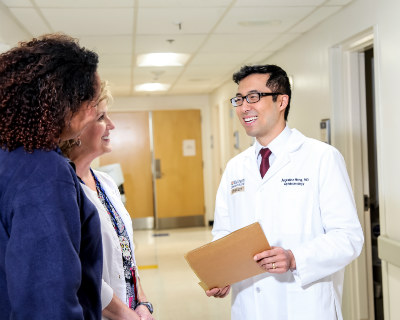Veteran Bobby Moyers was rapidly losing his vision to a degenerative eye disease.
After a cutting-edge transplant procedure, colors are once again brilliant and faces are in focus.
At age 70, Bobby Moyers found himself in a predicament. He had lost his health insurance and was rapidly losing his vision to a degenerative eye disease that required corneal transplant surgery. A Vietnam vet, he turned to his local Veterans Health Administration clinic for help. An ophthalmologist skilled in the latest advances in corneal surgery performed a cutting-edge transplant procedure at no cost, restoring his sight. After a decade struggling with cloudy vision that turned his world gray and blurry, colors are once again brilliant and faces are in focus.
"Will You Help Me?"

Augustine Hong, MD, speaks with staff at the VA Medical Center in St. Louis, Mo.
Moyers first realized something was wrong with his vision about 10 years ago. He needed more light to read the fine detail in manuals that guided his work as an electrician. He had good insurance, so he didn’t hesitate to see a physician. He had a cataract in one eye, a common condition quickly resolved with surgery.
But he had another condition attacking his cornea that was more difficult to treat. It’s a genetic disease that kills cells in the innermost layer of the cornea, leaving the eye unable to pump out excess fluid from the cornea. As the fluid levels rise, the cornea swells. Over time, vision becomes cloudy or hazy, making it hard to drive, read, watch television, or take part in other daily activities.
It’s called Fuchs’ corneal dystrophy, a common condition that affects approximately 4 percent of people over the age of 40 in the U.S. It’s also one of the most common reasons for the nearly 50,000 corneal transplants performed in the U.S. each year.
The cataract was removed, and Moyers was given a saline eye drop that helped ease the swelling in his corneas by pulling out the excess moisture. The eyedrops helped, but he still struggled to see clearly. Over the next decade, his vision slowly dimmed.
"It was like trying to see through murky water." – Bobby Moyers
“Eventually, everything was in grayscale,” he said. “It was like trying to see through murky water. I knew I wouldn’t be able to see before long.”
But at this point, he no longer had insurance. Unsure of where to turn for help, he called the John Cochran Division of the VA Medical Center in St. Louis, Mo.
He got an appointment with ophthalmologist Augustine Hong, MD, a corneal specialist. Dr. Hong told him the only cure was a corneal transplant. He also developed a cataract in his other eye. It would be best if he had both procedures performed at the same time.
“Will you be able to help me?” Moyers recalled asking Dr. Hong. “He looked at me and said 'Yes, I’ll take care of it for you.' I trusted him to do it.”
VA Delivers on Mission to Provide Veterans Sight-Saving Surgery
As a teaching hospital, the John Cochran Division of the VA Medical Center provides a full range of services, with state-of-the-art technology as well as education and research. About four years ago, the VA began offering the latest corneal transplant technique at the John Cochran Division. It’s called Descemet’s membrane endothelial keratoplasty (DMEK). Researchers have shown that it offers better vision and a faster recovery than older types of transplant procedures.
"If it hadn’t been for the VA, I just wouldn’t have been able to get it done." – Bobby Moyers
With this technique, ophthalmologists make a small incision and remove only the damaged layer of the cornea. The healthy donor tissue is rolled up, inserted through the incision and carefully unfurled. Instead of sutures, the tissue is held in place with an air bubble, which results in faster healing and leaves the eye stronger and less prone to accidental injury.
Since undergoing the procedure, Moyers is now able to see colors and details he hasn’t seen in years. He still needs glasses to correct his vision after the cataract was removed, but he says his vision is brilliant. “What the VA has done for me is beyond anything I could have expected,” Moyers said.
Dr. Hong notes that providing patients this sight-saving surgery at the VA has been a huge undertaking, requiring the coordination of many, including the local eye bank, which provides the donor tissue, and teams of nurses and administrative staff. He says he’s grateful to serve those who served this country.
Moyers, who served four years in the U.S. Navy as a hospital corpsman, is grateful to the VA for the high-quality care it provided him and to the 9 million other veterans it serves. “If it hadn’t been for the VA, I just wouldn’t have been able to get it done,” he said.